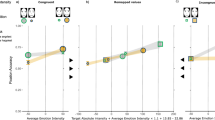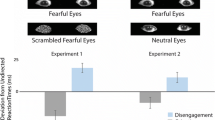Abstract
In the current study, we tested whether a fear advantage—rapid attraction of attention to fearful faces that is more stimulus-driven than to neutral faces—is emotion specific. We used a cueing task with face cues preceding targets. Cues were non-predictive of the target locations. In two experiments, we found enhanced cueing of saccades towards the targets with fearful face cues than with neutral face cues: Saccades towards targets were more efficient with cues and targets at the same position (under valid conditions) than at opposite positions (under invalid conditions), and this cueing effect was stronger with fearful than with neutral face cues. In addition, this cueing effect difference between fearful and neutral faces was absent with inverted faces as cues, indicating that the fear advantage is face-specific. We also show that emotion categorization of the face cues mirrored these effects: Participants were better at categorizing face cues as fearful or neutral with upright than with inverted faces (Experiment 1). Finally, in alternative blocks including disgusted faces instead of fearful faces, we found more similar cueing effects with disgusted faces and neutral faces, and with upright and inverted faces (Experiment 2). Jointly, these results demonstrate that the fear advantage is emotion-specific. Results are discussed in light of evolutionary explanations of the fear advantage.




Similar content being viewed by others
References
Bacon, W. F., & Egeth, H. E. (1994). Overriding stimulus-driven attentional capture. Perception and Psychophysics, 55, 485–496.
Bannerman, R. L., Milders, M., & Sahraie, A. (2010). Attentional bias to brief threat-related faces revealed by saccadic eye movements. Emotion, 10, 733–738.
Becker, D. V., Anderson, U. S., Mortensen, C. R., Neufeld, S. L., & Neel, R. (2011). The face in the crowd effect unconfounded: happy faces, not angry faces, are more efficiently detected in single-and multiple-target visual search tasks. Journal of Experimental Psychology: General, 140, 637–659.
Boll, S., Gamer, M., Kalisch, R., & Büchel, C. (2011). Processing of facial expressions and their significance for the observer in subregions of the human amygdala. Neuroimage, 56(1), 299–306.
Carretié, L., Ruiz-Padial, E., López-Martín, S., & Albert, J. (2011). Decomposing unpleasantness: differential exogenous attention to disgusting and fearful stimuli. Biological Psychology, 86, 247–253.
Chapman, H. A., & Anderson, A. K. (2012). Understanding disgust. Annals of the New York Academy of Sciences, 1251, 62–76.
Chapman, H. A., Johannes, K., Poppenk, J. L., Moscovitch, M., & Anderson, A. K. (2013). Evidence for the differential salience of disgust and fear in episodic memory. Journal of Experimental Psychology: General, 142, 1100–1112.
Cisler, J. M., & Olatunji, B. O. (2010). Components of attentional biases in contamination fear: evidence for difficulty in disengagement. Behaviour Research and Therapy, 48, 74–78.
Cisler, J. M., Olatunji, B. O., Lohr, J. M., & Williams, N. L. (2009). Attentional bias differences between fear and disgust: implications for the role of disgust in disgust-related anxiety disorders. Cognition and Emotion, 23, 675–687.
Davis, F. C., Somerville, L. H., Ruberry, E. J., Berry, A. B., Shin, L. M., & Whalen, P. J. (2011). A tale of two negatives: differential memory modulation by threat-related facial expressions. Emotion, 11, 647–655.
Deubel, H., & Schneider, W. X. (1996). Saccade target selection and object recognition: evidence for a common attentional mechanism. Vision Research, 36, 1827–1837.
Eastwood, J. D., Smilek, D., & Merikle, P. M. (2001). Differential attentional guidance by unattended faces expressing positive and negative emotion. Perception and Psychophysics, 63, 1004–1013.
Fischer, B., & Weber, H. (1993). Express saccades and visual attention. Behavioral and Brain Sciences, 16, 533–610.
Folk, C. L., Remington, R. W., & Johnston, J. C. (1992). Involuntary covert orienting is contingent on attentional control settings. Journal of Experimental Psychology: Human Perception and Performance, 18, 1030.
Fox, E., Russo, R., Bowles, R., & Dutton, K. (2001). Do threatening stimuli draw or hold visual attention in subclinical anxiety? Journal of Experimental Psychology: General, 130, 681.
Fox, E., Russo, R., & Dutton, K. (2002). Attentional bias for threat: evidence for delayed disengagement from emotional faces. Cognition and Emotion, 16, 355–379.
Fridlund, A. (1994). Human facial expression: An evolutionary view. San Diego: Academic Press.
Frischen, A., Eastwood, J. D., & Smilek, D. (2008). Visual search for faces with emotional expressions. Psychological Bulletin, 134, 662–676.
Hoffman, J. E., & Subramaniam, B. (1995). The role of visual attention in saccadic eye movements. Perception and Psychophysics, 57, 787–795.
Horstmann, G. (2003). What do facial expressions convey: feeling states, behavioral intentions, or action requests? Emotion, 3, 150–166.
Horstmann, G. (2009). Visual search for schematic affective faces: stability and variability of search slopes with different instances. Cognition and Emotion, 23, 355–379.
Horstmann, G., & Ansorge, U. (2009). Visual search for facial expressions of emotion: a comparison of dynamic and static faces. Emotion, 9, 29–38.
Horstmann, G., & Bauland, A. (2006). Search asymmetries with real faces: testing the anger-superiority effect. Emotion, 6, 193–207.
Horstmann, G., Scharlau, I., & Ansorge, U. (2006). More efficient rejection of happy than of angry face distractors in visual search. Psychonomic Bulletin & Review, 13, 1067–1073.
Jin, Z., & Reeves, A. (2009). Attentional release in the saccadic gap effect. Vision Research, 49, 2045–2055.
Koster, E. H., Crombez, G., Van Damme, S., Verschuere, B., & De Houwer, J. (2004). Does imminent threat capture and hold attention? Emotion, 4, 312.
Kowler, E., Anderson, E., Dosher, B., & Blaser, E. (1995). The role of attention in the programming of saccades. Vision Research, 35, 1897–1916.
Krusemark, E. A., & Li, W. (2011). Do all threats work the same way? Divergent effects of fear and disgust on sensory perception and attention. The Journal of Neuroscience, 31, 3429–3434.
Lang, P. J., Bradley, M. M., & Cuthbert, B. N. (1997). International affective picture system (IAPS): Technical manual and affective ratings. NIMH Center for the Study of Emotion and Attention, pp 39–58.
Laux, L., Glanzmann, P., Schaffner, P., & Spielberger, C. D. (1981). Das State-Trait-Anxiety-Inventory (STAI) [The state-trait anxiety inventory (STAI)]. German version. Göttingen: Hogrefe.
Leder, H., & Bruce, V. (2000). When inverted faces are recognized: the role of configural information in face recognition. The Quarterly Journal of Experimental Psychology, 53A, 513–536.
Lundqvist, D., Flykt, A., & Öhman, A. (1998). The Karolinska directed emotional faces—KDEF [CD ROM]. Stockholm: Karolinska Institutet, Department of Clinical Neuroscience, Psychology Section.
N’Diaye, K., Sander, D., & Vuilleumier, P. (2009). Self-relevance processing in the human amygdala: gaze direction, facial expression, and emotion intensity. Emotion, 9, 798–806.
Öhman, A. (1993). Fear and anxiety as emotional phenomenon: Clinical phenomenology, evolutionary perspectives, and information-processing mechanisms. In M. Lewis & J. M. Haviland (Eds.), Handbook of emotions (pp. 511–536). New York: Guilford Press.
Öhman, A., Flykt, A., & Esteves, F. (2001). Emotion drives attention: detecting the snake in the grass. Journal of Experimental Psychology: General, 130, 466–478.
Posner, M. I. (1980). Orienting of attention. Quarterly Journal of Experimental Psychology, 32A, 3–25.
Rozin, P., Haidt, J., & McCauley, C. R. (1993). Disgust. In M. Lewis & J. Haviland (Eds.), Handbook of emotions (pp. 575–594). New York: Guilford.
Saslow, M. G. (1967). Effects of components of displacement-step stimuli upon latency for saccadic eye movement. Journal of the Optical Society of America, 57, 1024–1029.
Savage, R. A., Lipp, O. V., Craig, B. M., Becker, S. I., & Horstmann, G. (2013). In search of the emotional face: anger versus happiness superiority in visual search. Emotion, 13, 758–768.
Susskind, J. M., Lee, D. H., Cusi, A., Feiman, R., Grabski, W., & Anderson, A. K. (2008). Expressing fear enhances sensory acquisition. Nature Neuroscience, 11, 843–850.
van Hooff, J. C., Devue, C., Vieweg, P. E., & Theeuwes, J. (2013). Disgust-and not fear-evoking images hold our attention. Acta Psychologica, 143, 1–6.
Vermeulen, N., Godefroid, J., & Mermillod, M. (2009). Emotional modulation of attention: fear increases but disgust reduces the attentional blink. PLoS ONE, 4(11), e7924.
Vogt, J., Lozo, L., Koster, E. H., & De Houwer, J. (2011). On the role of goal relevance in emotional attention: disgust evokes early attention to cleanliness. Cognition and Emotion, 25, 466–477.
Whalen, P. J. (1998). Fear, vigilance, and ambiguity: initial neuroimaging studies of the human amygdala. Current Directions in Psychological Science, 7, 177–188.
Yang, E., Zald, D. H., & Blake, R. (2007). Fearful expressions gain preferential access to awareness during continuous flash suppression. Emotion, 7, 882–886.
Acknowledgments
Supported by Deutsche Forschungsgemeinschaft Grant KH 341/1-1 to Shah Khalid. We thank Erica Krcal and Julia Riedl for help with the data collection.
Author information
Authors and Affiliations
Corresponding author
Rights and permissions
About this article
Cite this article
Khalid, S., Horstmann, G., Ditye, T. et al. Measuring the emotion-specificity of rapid stimulus-driven attraction of attention to fearful faces: evidence from emotion categorization and a comparison with disgusted faces. Psychological Research 81, 508–523 (2017). https://doi.org/10.1007/s00426-016-0743-8
Received:
Accepted:
Published:
Issue Date:
DOI: https://doi.org/10.1007/s00426-016-0743-8




